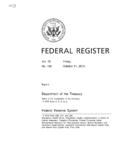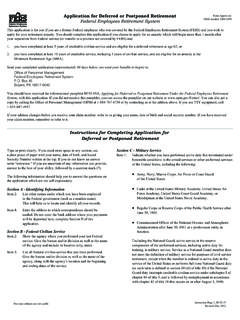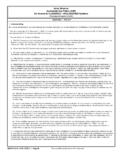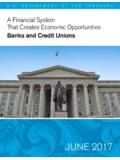Transcription of The Changed Role of the Lender of Last Resort: …
1 Institute for International Political Economy Berlin The Changed Role of the Lender of Last Resort: Crisis Responses of the federal reserve , European Central Bank and Bank of England Author: Gayane Oganesyan Working Paper, No. 19/2013. Editors: Trevor Evans Eckhard Hein Hansj rg Herr . Sigrid Betzelt Martin Kronauer Birgit Mahnkopf Achim Truger The Changed Role of the Lender of Last Resort: Crisis Responses of the federal reserve , European Central Bank and Bank of England*. Gayane Oganesyan Abstract This paper analyzes whether the Lender of Last Resort function has Changed in consequence of the recent Global Financial Crisis. The unprecedented emergency actions of the federal reserve , European Central Bank and the Bank of England are analyzed in terms of Walter Bagehot's traditional Lender of Last Resort doctrine.
2 The central banks' actions are compared to identify the extensions and paint a general picture of the modern and much more comprehensive Lender of Last Resort function, which includes provision of liquidity and collateral, lowering interest rates and expansionary monetary policy, loosening collateral standards, supporting critical institutions, opening special liquidity facilities that target specific markets or groups of agents, and becoming market maker of last resort and buyer of last resort. The Lender of Last Resort function has been found to have Changed . Keywords: Lender of Last Resort, Walter Bagehot's Lombard Street, penalty rate, secure collateral, solvency and illiquidity, monetary policy, federal reserve Bank, European Central Bank, Bank of England, Market Maker of Last Resort, quantitative easing, Buyer of Last Resort Contact: Gayane Oganesyan Berlin School of Economics and Law Badensche Strasse 50-51.
3 10825 Berlin E-mail: *. I am grateful to Professor Hansj rg Herr for the invaluable discussions and suggestions, as well as to Professor Achim Truger for helpful comments. Introduction The recent global financial crisis has been compared in magnitude to the Great Depression of 1930s and required central banks around the world to implement comprehensive Lender of Last Resort measures to constrain it. Since this crisis has been special in its own right, it is likely that the traditional Lender of Last Resort function has been Changed to better and more effectively address the instability of the financial system. This paper analyses whether the Lender of Last Resort function has been Changed as a result of the recent crisis, and if so, what are the main reasons.
4 In order to answer these questions, Walter Bagehot's traditional Lender of Last Resort theory and its modern interpretations are examined in Section 1. Section 2 provides a detailed analysis of the actions of the federal reserve (Fed), European Central Bank (ECB) and Bank of England 1 (BOE) in terms of Bagehot's traditional Lender of Last Resort criteria. This analysis includes the identification of each of the central banks'. deviations from the criteria. In Section 3, the central banks' Lender of Last Resort operations are compared to find similarities and differences, thereby painting a general picture of the recently extended or modified Lender of Last Resort function. The explanation of and reasons for the discovered differences and similarities are provided in the same section.
5 1. The Classical Lender of Last Resort Theory Walter Bagehot's Lender of Last Resort Doctrine In Lombard Street: A Description of the Money Market (1962 [1873]), Walter Bagehot extended the ideas of Henry Thornton (1802) and formulated the most well-known Lender of Last Resort (LLR) theory. He described not only the role and function of a central bank as LLR, but also its main operational principles. Like Thornton, Bagehot stressed that the central bank was unique in comparison to commercial banks, because it was the ultimate holder of liquid reserves or high-powered money (Bagehot 1962: 85, Humphrey 1989: 13). Hence, when commercial banks contract lending in times of panics or crises, the central bank has the ability and duty to lend and satisfy liquidity demands.
6 Apart from protecting the money stock and ensuring stable money growth 2 , the main task of the central bank as LLR 3 is to constrain 1. These three main central banks were selected because they produce the world's dominating currencies and extensively intervene in financial markets to stabilize the system. 2. These were considered the main goals of a central bank in 19th century Britain. For more information see the Currency School vs. Banking School debate in Daugherty (1942). 3. In fact, the traditional LLR policy is intertwined with central bank's function of controlling the money stock (Humphrey 2010). 1. financial panics or prevent an initial default of a financial institution from triggering waves of subsequent failures throughout the system (Bagehot 1962: 29).
7 In fulfilling this task, Bagehot believed the central bank should be guided by four main principles: (1) lend freely and to the public, (2) at a penalty rate, (3) to any actors with good collateral (4) who are illiquid but solvent. These principles, described in more detail below, constitute Bagehot's invaluable contribution to LLR theory. 1. Willingness to lend freely and to the public To Bagehot, LLR role is primarily a macroeconomic one, which also means that the LLR. should provide liquid funds to the whole system and not just specific institutions (Bagehot 1962: 25). The public should also be assured that the central bank acknowledges its LLR. function and is ready to step in at any future time of need.
8 For instance, Bagehot states that the public have a right to know whether the holders of our ultimate bank reserve . acknowledge this duty, and are ready to perform it (Ibid: 85). 2. Lending at a penalty rate. Bagehot claims that very large loans at very high rates are the best remedy for the worst malady of the money market when a foreign drain is added to a domestic drain (Bagehot 1962: 27-28). Since the theory was written at the time of the Gold Standard, high penalty rates would secure a nation's gold reserve by simultaneously attracting specie from abroad and preventing any outbound drains. The penalty rate serves other additional purposes. For example, high cost of borrowing from the central bank would encourage quick repayment of loans once the crisis ends.
9 According to Bagehot, this would neutralize any emergency credit expansion and ensure stable growth of money stock's note component. It should also prevent any misuse of central bank's lending and moral hazard. The central bank would be rewarded for providing the liquidity and protection, while commercial banks would only borrow out of dire need and not precaution. As Bagehot claims, the penalty rate is a heavy fine on unreasonable timidity (Ibid: 97). Considering all of the above, the penalty or above-the- market rate would ensure that the Bank of England reserve may be protected as far as possible (Bagehot 1962: 97). 3. Accommodation of any actors with good collateral. Last resort loans should be made to merchants, to minor bankers, to this man and that man.
10 (Bagehot 1962: 25), which is consistent with the duty of the LLR to lend to the public and 2. satisfy the market's demand for liquidity. On the other hand, the borrower should not only be willing to pay the penalty rate, but also provide good collateral to receive the loan. According to Bagehot (Ibid: 97), LLR should lend on every kind of security, or every sort on which money is ordinarily and usually lent. He even promoted the use of non-traditional collateral in crises, such as railway debenture stock (Ibid: 101). However, Bagehot appears to contradict himself by saying that the LLR should refuse bad bills or bad securities and that this will not make the panic really worse (Ibid: 97).





